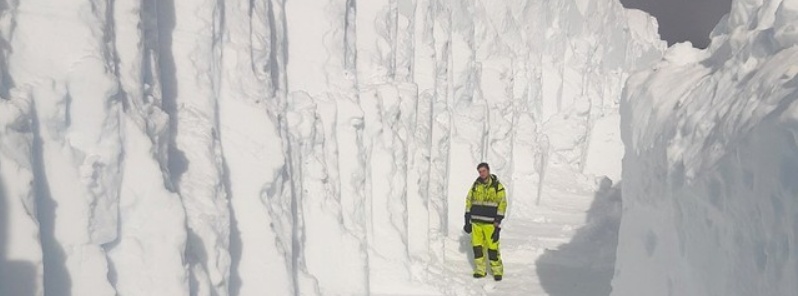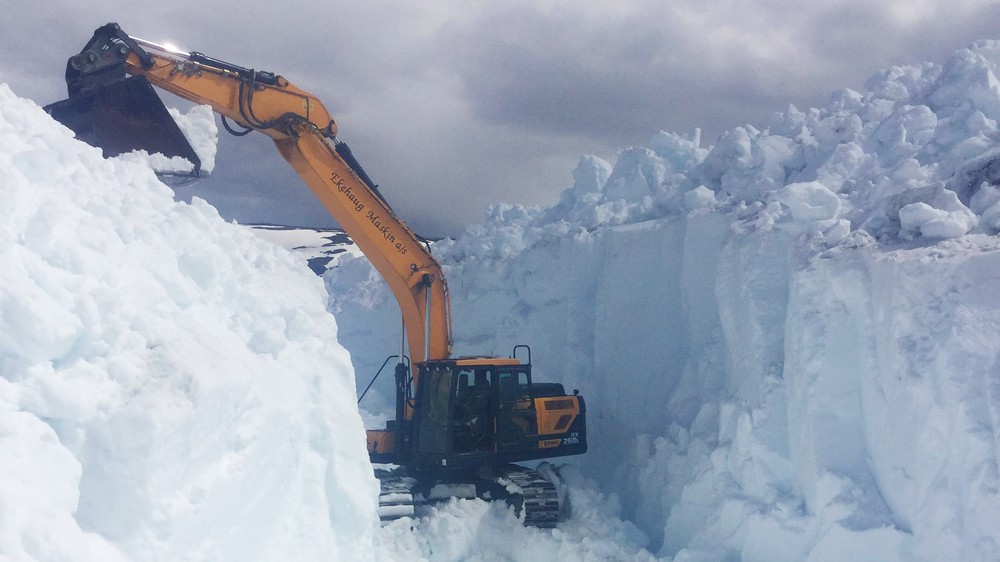Southern Norway enters July with record 10 m (32 feet) of snow

More than 10 m (32 feet) of snow accumulated in parts of southern Norway by July, according to the BKK energy company, who is conducting clearing operations to prevent flooding in the mountains. The region is currently so cold that the snow is hardly melting, but the situation could change with heavy rainfall, causing rapid melting.
"We have not had such [heavy] snowfall as this year," said Knut Kinne, watercourse technical manager at BKK.
Reservoirs are almost full, there's lots of snow and sealed channels, threatening mountainous regions of southern Norway, Kinne said. The goal of snow removal is to prevent melting into the almost full channels, BKK said.

Snow removal in southern Norway – July 2020. Credit: BKK
Even with all the snow removed from the channels, Kinne is not sure there won't be floods in the region. There can be large amounts of rainfall causing rapid melting and risking overflow, he explained.
"It can be quite local in the mountains if it melts intensely, but it is not something we see immediately on meteorological forecasts," hydrologist Knut Ola Aamodt said.
According to the Norwegian Water Resources and Energy Directorate (NVE), the flood warning is currently green as the region is currently so cold that the snow is hardly melting.
Just a few days ago, Oppland County, located in the southern region near Lillehammer, at about 2 000 m (6 562 feet) above sea level, registered -6.3 °C (20.7 °F), breaking the previous record cold temperature set in 1964.
Cold winds have brought rare July snow to several northern parts of #Norway. Just over a week ago, the country was sizzling in record temperatures.
Here's Oppland county at the moment pic.twitter.com/K1JXl4EHhe— BBC Weather (@bbcweather) July 6, 2020
Meanwhile in #Norway… #Summer holiday? Pack your skis! A whopping 40cm of fresh #snow fell last night in Fonna, Hardanger. Photo via FONNA Glacier Ski Resort #weather @fjordnorway pic.twitter.com/N69pctu0yR
— Elusive Moose (@elusive_moose) July 4, 2020
In early July, 35 cm (14 inches) of snow fell in some parts of the country. While accumulations of about 5 cm (2 inches) are possible in July, totals of more than that are almost unheard of.
Three major roads that link east and west Norway were disrupted, and drivers were urged to revert to using winter tires.
35 cm of fresh snow in mountains over Bergen in Norway
What it looks like at the Folgefonna ski centre in Jondal (about 1200 m asl) on Friday, July 3rd. https://t.co/EQeFKL41V5https://t.co/sJ9bK6uJ6Y pic.twitter.com/zFGCds0euW— Zdenek Nejedly (@ZdenekNejedly) July 3, 2020
We drove through many tunnels. Norway has plenty of tunnels. Then we went up again to over 300m. We saw some snow and clouds pic.twitter.com/aiKwmJEMTA
— Viiru The Cat (@kissanelamaa) July 7, 2020
Has come snow in the north in Norway the night that was pic.twitter.com/gVIqxHhJTz
— Herr Larsson (@HerrLarsson2) July 6, 2020
RT: @snowforecast: July summer powder skiing in Norway today as the sun returned to @Folgefonna Glacier Ski Resort after 40cm (16") of snowfall yesterday. pic.twitter.com/sdHXTAG9Qp
— Snow.Guide (@thesnowguide) July 6, 2020
Featured image credit: BKK

The magnetic north pole crosses the LOMONOSOV ridge 2020/2023 (?). —— Remember 2009/2011 when crossing the ALPHA ridge and now 2020 also the deadliest monsoon in 11 years in Nepal. Climate change is the result of the magnetic excursion, the solar wind is modulated in the stratosphere according to the 3D (not 2D) geographic positions of the magnetic poles.
GLOBAL WARMING GOT BURRIED UNDER A HEAP OF OF SNOW
AL GORE IS RIGHT, MAN-MADE CLIMATE CHANGE IS ALSO THE REASON FOR THE RECORD SNOW AND FREEZING TEMPERATURES EVEN IN THE NORTHERN HEMISPHERE DURING JULY, HAHAHAHAHA
What happened to Global Warming?